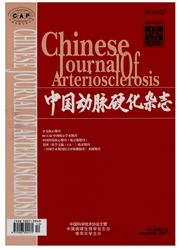

 中文摘要:
中文摘要:
Objective Very early-onset coronary artery disease(CAD) is a great challenge in cardiovascular medicine throughout the world,especially regarding its early diagnosis.This study explored whether circulating micro RNAs(mi RNAs) could be used as potential biomarkers for patients with very early-onset CAD.Methods We performed an initial screening of mi RNA expression using RNA isolated from 20 patients with angiographically documented very early-onset CAD and 20 age-and sex-matched normal controls.For further confirmation,we prospectively examined the mi RNAs selected from 40 patients with very early-onset CAD and 40 angiography-normal controls.Results A total of 22 overexpressed mi RNAs and 22 underexpressed mi RNAs were detected in the initial screening.RT-q PCR analysis of the mi RNAs obtained from the initial screening revealed that four mi RNAs including mi R-196-5p,mi R-3163-3p,mi R-145-3p,and mi R-190a-5p exhibited significantly decreased expression in patients compared with that in controls(P<0.05).The areas under the receiver operating characteristic curve for these mi RNAs were 0.824(95% CI,0.731-0.917;P<0.001),0.758(95% CI,0.651-0.864;P<0.001),0.753(95% CI,0.643-0.863;P<0.001),and 0.782(95% CI,0.680-0.884;P<0.001),respectively,in the validation set.Conclusion To our knowledge,this is an advanced study to report about four serum mi RNAs(mi R-196-5p,mi R-3163-3p,mi R-145-3p,and mi R-190a-5p) that could be used as novel biomarkers for the diagnosis of very early-onset CAD.
 英文摘要:
英文摘要:
Objective Very early-onset coronary artery disease (CAD) is a great challenge in cardiovascular medicine throughout the world, especially regarding its early diagnosis. This study explored whether circulating microRNAs (miRNAs) could be used as potential biomarkers for patients with very early-onset CAD. Methods We performed an initial screening of miRNA expression using RNA isolated from 20 patients with angiographically documented very early-onset CAD and 20 age- and sex-matched normal controls. For further confirmation, we prospectively examined the miRNAs selected from 40 patients with very early-onset CAD and 40 angiography-normal controls. Results A total of 22 overexpressed miRNAs and 22 underexpressed miRNAs were detected in the initial screening. RT-qPCR analysis of the miRNAs obtained from the initial screening revealed that four miRNAs including miR-196-5p, miR-3163-3p, miR-145-3p, and miR-190a-5p exhibited significantly decreased expression in patients compared with that in controls (P〈0.05). The areas under the receiver operating characteristic curve for these miRNAs were 0.824 (95% CI, 0.731-0.917; P〈0.001), 0.758 (95% CI, 0.651-0.864; P〈0.001), 0.753 (95% CI, 0.643-0.863; P〈0.001), and 0.782 (95% CI, 0.680-0.884; P〈0.001), respectively, in the validation set. Conclusion To our knowledge, this is an advanced study to report about four serum miRNAs (miR-196-5p, miR-3163-3p, miR-145-3p, and miR-190a-5p) that could be used as novel biomarkers for the diagnosis of very early-onset CAD.
 同期刊论文项目
同期刊论文项目
 同项目期刊论文
同项目期刊论文
 RANTES Gene G-403A Polymorphism and Coronary Artery Disease: A Meta Analysis of Observational Studie
RANTES Gene G-403A Polymorphism and Coronary Artery Disease: A Meta Analysis of Observational Studie Different impacts of C-reactive protein and lipid profile on coronary lesions following a percutaneo
Different impacts of C-reactive protein and lipid profile on coronary lesions following a percutaneo Correlation of red cell distribution width with the severity of coronary artery disease: a large Chi
Correlation of red cell distribution width with the severity of coronary artery disease: a large Chi Role of plasma C-reactive protein in predicting in-stent restenosis in patients with stable angina a
Role of plasma C-reactive protein in predicting in-stent restenosis in patients with stable angina a 期刊信息
期刊信息
